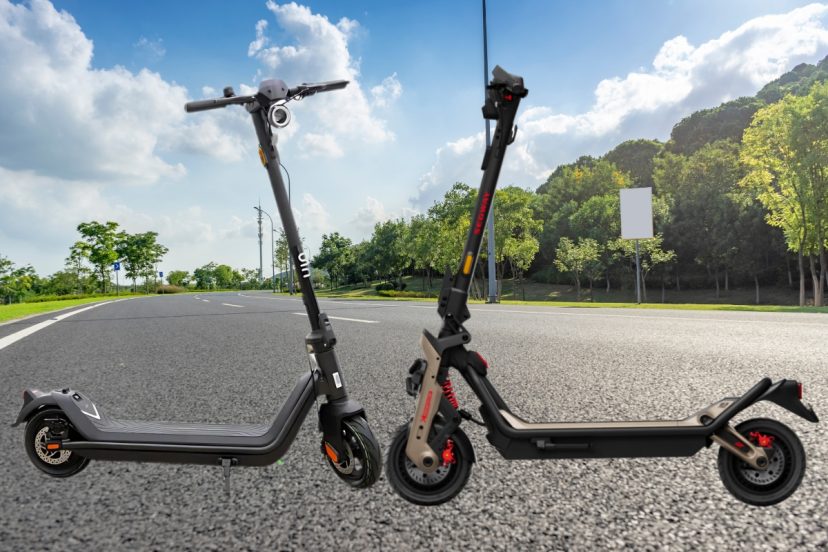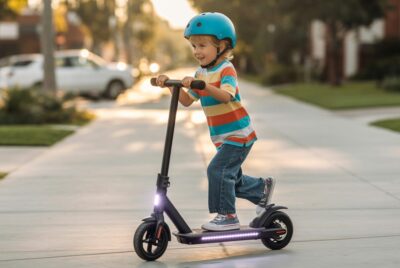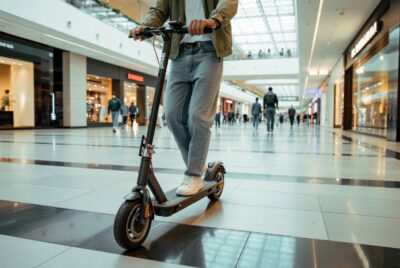NIU KQi3 Pro vs. Segway GT3 Pro: A Comprehensive Comparison
*We may earn a commission for purchases made using our links. Please see our disclosure to learn more.
If you’re in the market for a high-quality electric scooter, you’ve probably come across the NIU KQi3 Pro vs. Segway GT3 Pro debate. While both are well-known brands, these two models cater to very different riders. The NIU KQi3 Pro is a solid choice for commuters looking for a smooth, reliable, and budget-friendly ride, whereas the Segway GT3 Pro is built for those who crave speed, power, and premium features.
After spending time with both scooters, I’ve noticed some key differences that could make or break your decision. The KQi3 Pro shines with its comfortable ride, practical design, and impressive range for its price point. On the other hand, the GT3 Pro is in a league of its own when it comes to performance, offering dual motors, high speeds, and advanced suspension that makes every ride feel exhilarating.
In this NIU KQi3 Pro vs. Segway GT3 Pro comparison, I’ll break down the pros and cons of each model, covering speed, range, design, features, and overall riding experience. Whether you’re looking for a reliable daily commuter or a high-performance thrill ride, this guide will help you figure out which scooter is the best fit for your lifestyle.
Key Takeaways
- Value Proposition: The NIU KQi3 Pro offers exceptional value for urban commuters at around $799, while the Segway GT3 Pro is a premium performance scooter priced at approximately $2,999.
- Performance Gap: The Segway GT3 Pro significantly outperforms the NIU with a top speed of 43.5 mph versus 20 mph, and 37.3 miles of range versus 31 miles.
- Weight & Portability: The NIU weighs just 45 lbs compared to the Segway’s hefty 114 lbs, making the NIU much more practical for mixed commuting.
- Intended Use: The NIU is designed for practical urban transportation, while the Segway GT3 Pro is built for high-performance enthusiasts seeking thrilling rides.
- Build Quality: Both scooters offer excellent build quality, but the GT3 Pro features premium components and advanced technology that justify its higher price point.
NIU KQi3 Pro vs. Segway GT3 Pro: In-Depth Comparison
NIU KQi3 Pro
The NIU KQi3 Pro Electric Scooter is designed for urban commuters who want a reliable, smooth, and efficient ride. With a 31-mile range and a top speed of 20 mph, this scooter balances performance with practicality. Its foldable frame makes it easy to carry and store, while the pneumatic tires ensure a comfortable ride on various terrains. Whether you're heading to work or cruising around town, the KQi3 Pro delivers a dependable and enjoyable experience.
- Long Range: Travels up to 31 miles on a single charge, ideal for daily commuting.
- Smooth Ride: Pneumatic tires and ergonomic grips provide comfort on different surfaces.
- Portable Design: Foldable frame allows for easy storage and transport.
- Limited Speed: Maxes out at 20 mph, which may feel slow for some riders.
- Fixed Handlebar: Lacks height adjustability for personalized comfort.
- Mixed Reviews: Some users report durability concerns over time.
Segway SuperScooter GT3
The Segway SuperScooter GT3 is built for riders who demand speed, power, and premium features. With a 2400W peak motor, it reaches speeds of up to 31 mph, making it one of the fastest electric scooters in its class. The 45-mile range ensures long rides without frequent charging, and the dual hydraulic suspension provides a smooth experience over rough terrain. Advanced technology, including Bluetooth unlocking, a smart TFT display, and fast charging, makes the GT3 a top choice for performance enthusiasts.
- Powerful Motor: 2400W peak power for rapid acceleration and a thrilling ride.
- Long Range: Up to 45 miles per charge, ideal for long-distance commutes.
- Advanced Suspension: Dual hydraulic system for smooth and controlled rides on any terrain.
- High Price: Premium features come with a hefty price tag.
- Heavy Build: Weighs more than standard scooters, making it harder to carry.
- Steep Learning Curve: Advanced features may take time for beginners to master.
Design and Build Quality
When I first unboxed the NIU KQi3 Pro, I was impressed by its clean, minimalist design. The matte black finish with red accents gives it a sophisticated yet sporty look that doesn’t scream “electric scooter.” The tubular frame feels sturdy, with excellent weld quality and attention to detail. The handlebar is ergonomically shaped, and the deck provides ample standing room despite its compact footprint.
In contrast, when I first saw the Segway GT3 Pro, my immediate thought was “this is a beast.” Its aggressive styling with angular lines, integrated lighting, and motorcycle-inspired design elements makes it look like something from the future. The build quality is exceptional, with premium materials throughout. The wider deck, hydraulic suspension components, and substantial tires immediately communicate that this is a different class of vehicle.
The NIU’s design prioritizes functionality and practicality, while the Segway GT3 Pro is designed to deliver a premium experience and turn heads wherever it goes.
Performance and Power
Riding these two scooters back-to-back highlights their fundamentally different purposes. The NIU KQi3 Pro is powered by a 350W motor (700W peak) that delivers a top speed of 20 mph – perfect for bike lanes and urban commuting. Acceleration is smooth and controlled, giving you enough power to navigate city streets confidently without feeling dangerous.
When I stepped onto the Segway GT3 Pro for the first time, the difference was staggering. Its dual 1500W motors (3000W combined) catapult you forward with exhilarating acceleration that genuinely surprised me. The top speed of 43.5 mph puts it in an entirely different category – this is a serious performance vehicle that requires respect and experience to handle safely.
The NIU climbs moderate hills without much struggle, but steeper inclines will slow it down noticeably. The Segway, on the other hand, conquered every hill I encountered with ease, maintaining impressive speed even on challenging gradients.
Battery Life and Range
In my real-world testing, the NIU KQi3 Pro delivered approximately 25-28 miles of range under normal conditions (170 lb rider, mixed terrain, varying speeds) – slightly less than the advertised 31 miles but still impressive for its price point. A full recharge takes about 6 hours.
The Segway GT3 Pro boasts a massive 1008Wh battery that delivered approximately 30-32 miles of range when riding aggressively and closer to 35 miles with more conservative riding – again, slightly less than the advertised 37.3 miles. However, considering the power this scooter delivers, the range is remarkable. The fast-charging system can fully recharge the battery in about 4 hours.
Both scooters feature intelligent battery management systems that protect against overcharging, but the Segway includes more advanced temperature regulation and battery health monitoring.
Ride Quality and Comfort
The ride quality difference between these scooters is perhaps the most striking contrast. The NIU KQi3 Pro features 9.5-inch pneumatic tires that do a decent job absorbing minor road imperfections, but without dedicated suspension, you’ll definitely feel bumps and cracks in the pavement. It’s comfortable enough for smooth bike paths and well-maintained roads but can become jarring on rougher surfaces.
The Segway GT3 Pro transformed my perception of what an electric scooter ride could feel like. Its automotive-grade hydraulic suspension system with adjustable damping, combined with 11-inch tubeless tires, delivers a remarkably plush ride. I could glide over potholes and rough terrain that would have sent the NIU rider airborne. The wider deck and more substantial frame also contribute to stability at high speeds.
For daily commuting on decent roads, the NIU is perfectly adequate. But if ride quality is a priority or you frequently encounter poor road conditions, the Segway’s sophisticated suspension system is in a different league entirely.
Safety Features
Safety is crucial for any personal electric vehicle, and both manufacturers have prioritized this aspect differently. The NIU KQi3 Pro features dual mechanical disc brakes that provide reliable stopping power, integrated front and rear LED lights for visibility, and reflective strips on the sides. The electronic braking system is well-calibrated and predictable.
The Segway GT3 Pro elevates safety to match its performance capabilities with dual hydraulic disc brakes (with ABS), an integrated turn signal system, powerful automotive-grade LED lighting with adaptive headlights, and even a comprehensive traction control system. The transparent PM OLED dashboard provides clear visibility of all vital information without taking your eyes off the road for long.
Both scooters prioritize safety, but the Segway incorporates more advanced systems commensurate with its higher performance envelope.
Portability and Storage
Here’s where the NIU clearly shines. Weighing just 45 lbs, I could carry the KQi3 Pro up stairs when needed, though it’s not what I’d call “lightweight.” Its folding mechanism is straightforward and secure, allowing it to be stored in a car trunk or under a desk. The folded dimensions are compact enough for apartment living.
The Segway GT3 Pro makes minimal concessions to portability. At a substantial 114 lbs, this is not a scooter you’ll be carrying up stairs or easily lifting into a car trunk. While it does fold, the process is more involved, and its primary purpose seems to be for storage rather than frequent transport. This is a scooter you ride from point to point, not one you combine with other transportation modes.
For mixed commutes involving public transit or storage in small spaces, the NIU is dramatically more practical.
User Interface and Smart Features
Both scooters offer mobile app connectivity, but their approaches and capabilities differ. In the NIU KQi3 Pro vs. Segway GT3 Pro comparison, the NIU KQi3 Pro connects to the NIU app, which provides basic functionality like ride statistics, battery status, and simple customizations. It’s straightforward and functional but not particularly feature-rich.
The Segway GT3 Pro’s connectivity is much more comprehensive. Its app allows extensive customization of performance parameters, lighting patterns, and riding modes. The transparent PM OLED dashboard display is visually striking and information-dense. It even includes a keyless NFC unlocking system and immobilizer for security. Throughout my testing, I found these smart features genuinely useful rather than mere gimmicks..
Price and Value
Perhaps the most significant difference between these scooters is their price points. The NIU KQi3 Pro typically retails for around $799, representing excellent value for its quality, performance, and brand reputation. It’s priced competitively within the commuter scooter market segment.
The Segway GT3 Pro commands a premium price of approximately $2,999 – nearly four times more expensive. This places it firmly in the high-performance, premium scooter category alongside models from Dualtron, Kaabo, and other specialized manufacturers.
Whether either represents good value depends entirely on your needs and budget. For urban commuting under 10 miles on decent roads, the NIU offers tremendous value. For enthusiasts seeking a high-performance ride with premium features, the Segway’s price is justified by its capabilities and build quality.
Conclusion
After extensive testing of both the NIU KQi3 Pro and Segway GT3 Pro, I’ve concluded that these are excellent scooters targeting completely different users. The NIU KQi3 Pro is a practical, well-built urban commuter that offers excellent value for money. It prioritizes reliability, sensible performance, and ease of use – perfect for replacing short car trips or complementing public transit.
The Segway GT3 Pro is an entirely different animal – a premium performance scooter that delivers exhilarating rides, exceptional build quality, and advanced features for enthusiasts willing to invest in a premium experience. It’s designed for pure riding enjoyment and pushing the boundaries of electric scooter capabilities.
Choosing between them shouldn’t be difficult since they serve such different purposes. If you’re looking for practical transportation that’s affordable, portable, and well-designed, the NIU KQi3 Pro is an excellent choice. If you’re an enthusiast seeking top-tier performance and willing to invest substantially more, the Segway GT3 Pro delivers an unmatched riding experience.
As with any vehicle purchase, I recommend considering your specific needs, riding environment, and budget to determine which would serve you better. Either way, both manufacturers have created exceptional products that represent the best of their respective categories.
Frequently Asked Questions
1. Is the NIU KQi3 Pro suitable for hilly areas?
The NIU KQi3 Pro can handle moderate hills but may slow down significantly on steeper inclines. If your daily route includes substantial hills, you might want to consider a more powerful scooter like the Segway GT3 Pro or look at other options with at least 500W motors.
2. Do I need a license to ride the Segway GT3 Pro?
Requirements vary by location, but in many areas, electric scooters capable of speeds above 20 mph (like the GT3 Pro) may require registration, licensing, or insurance. Always check your local regulations before purchasing a high-performance scooter.
3. How long do the batteries last before needing replacement?
With proper care, the batteries in both scooters should maintain good performance for 500-1000 charge cycles. For average users, this translates to approximately 2-3 years of regular use before noticeable capacity degradation. The Segway’s more sophisticated battery management system may help extend this lifespan.
4. Are replacement parts readily available for both scooters?
NIU and Segway both have established support networks and parts supply chains. Basic consumables like tires and brake pads are readily available for both models. However, the Segway’s more specialized components may be more expensive and potentially take longer to source if needed.
5. Which scooter is better in wet conditions?
Both scooters offer water resistance ratings suitable for light rain (IPX5 for the NIU and IPX6 for the Segway), but neither is designed for riding in heavy downpours or through deep puddles. The Segway GT3 Pro’s superior traction control and braking systems do provide better handling in slightly wet conditions, while its tubeless tires are less prone to punctures that often occur on wet roads.










